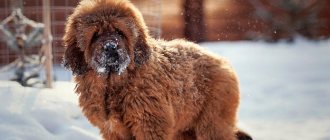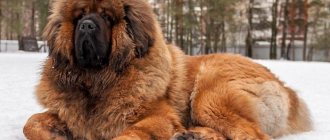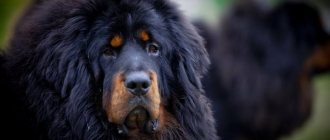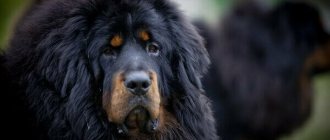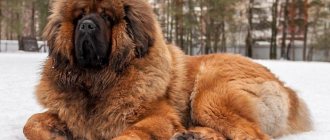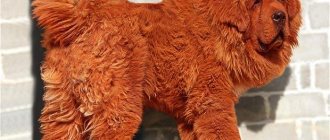Pros and cons of the breed
The Tibetan Mastiff dog breed has the following advantages:
- high intelligence;
- excellent security qualities;
- calm and majestic disposition;
- attachment to the owner and family;
- unpretentiousness in nutrition and care;
- independence;
- friendliness and rare manifestations of aggression;
- adaptability to cold climates.
There are also some disadvantages:
- very large size and impossibility of keeping a dog in an apartment;
- the need for mandatory training;
- very high price;
- frequent walking;
- heavy shedding.
Because of these shortcomings, the Tibetan Mastiff is best owned only by experienced dog breeders who can provide it with the right conditions for its existence.
Conclusion
The Tibetan Mastiff was bred in China for protection. Later, thanks to the king of Nepal, the breed spread throughout European countries and America. For Russia, this mountain dog is a rarity, but is in great demand, which is why it is expensive (75-150 thousand rubles).
The Mastiff is in good health (especially girls), he is a born guard and is ready to constantly monitor his possessions. This dog is designed for a large area; it will be cramped in an apartment. Proper upbringing from puppyhood will make the Tibetan giant an obedient and friendly family member.
Breed characteristics
| Attitude towards children is normal (rating 3/5) | shedding (rating 5/5) | Noise Average (rating 3/5) |
| Cautious attitude towards strangers (rating 3/5) | Need for communication Above average (rating 4/5) | Security qualities Excellent (rating 5/5) |
| health (rating 3/5) | Friendliness High (rating 4/5) | Size Extra large (rating 5/5) |
| pickiness to food (rating 5/5) | Activity Above average (rating 4/5) | Maintenance cost High (rating 5/5) |
| Training is difficult (rating 5/5) | Intelligence High (rating 4/5) | Price High (rating 5/5) |
History of the breed
The beginning of the history of the Tibetan Mastiff breed is hidden in centuries. It is only known that dogs descended from purebred wolves, without jackal genes, which is typical for other breeds. Some scientists believe that the animal remains found in Tibet belong to dogs that were the ancestors of mastiffs, but there is no confirmation of such information.
Until the 7th century, there are no written references to the breed, so this date is considered the official beginning of its history, when Herodotus in his writings described dogs that were very similar in appearance and character to modern mastiffs. Further mentions date back to 1271. They were made by the traveler Marco Polo, when, while traveling in Tibet, he saw the indigenous people with huge, but intelligent and non-aggressive dogs. Until the 19th century, the breed was not studied in any way, and no attempts were made to breed it. This is due to the complete isolation of the mountainous regions of Tibet and the lack of communication with the then empire. This made it possible to maintain the purity of mastiffs and avoid connections with dogs of other breeds.
When Europe finally became interested in the unusual Tibetan dogs in the mid-19th century, several puppies were brought to England and Germany. The first attempts were made to breed them, but they were unsuccessful - the offspring did not survive. A breakthrough occurred only after 1880, when the natural living conditions and breeding of Tibetan dogs were described. Mastiffs began to be imported into European countries more and more often, and there were more breeders. Success in breeding was achieved only at the beginning of the 20th century. In the Berlin Zoo, puppies from imported Tibetans not only survived, but also gave birth to their own offspring.
Despite the fact that the wars of the first half of the 20th century significantly slowed down the development of the breed, in the 50-60s they had already spread throughout Europe and appeared in the USA. The breed was officially registered, the standard was approved, and the dogs were allowed to participate in exhibitions.
Owner reviews
Adult Tibetan mastiffs, especially males, have incredible courage, luxurious fur and a mane, almost like a lion. Bitches are distinguished by greater devotion to the family, as well as a more subtle, rich and complex psyche. Bitches, in the process of training, learn commands faster and are not as stubborn as males.
It is important to know! The Tibetan Mastiff is a full member of the family. He takes part in all important events and perfectly senses the changes in the mood of all family members.
Owners of this breed note that dogs are quite distrustful of strangers and do not show distrust of family members. They behave with restraint, but are always ready to protect the owner’s property and himself, while they are calm and balanced. If there are no visible reasons for this, then Tibetan mastiffs are not capable of unmotivated aggression. Despite its enormous size for a dog, this breed gets along well in any family, regardless of the number of residents. As a rule, Tibetan Mastiffs eventually become true friends and companions.
Tibetan Mastiff - All about the dog breed | Dog breed - Tibetan Mastiff
Appearance
Tibetan mastiffs have an unusual, memorable appearance.
Brief description of appearance
These are huge dogs with long hair and a strong build. They have a large muzzle, powerful paws, and a rounded tail. A distinctive feature is the elongated hair on the neck, which forms a mane, due to which mastiffs resemble lions. In general, their appearance is beautiful and noble, which fully corresponds to their character.
Dimensions
Mastiffs are very large in size. The height of males starts from 65 centimeters and can reach 75-80. Weight ranges from 60 to 80 kilograms depending on size and age.
Females grow to a height of 60 to 70-73 centimeters. Their weight is slightly less - from 50 to 75 kilograms. In the breed standard, it is important that the height and weight indicators correspond to the gender of the dog and the harmonious ratio of the indicators.
Head
The head of mastiffs is large, proportional, the neck is wide and powerful. Due to the thick fur, the transition between the neck and head is poorly defined.
The muzzle is wide, slightly smaller in size than the skull, the transition between them is clearly visible. The nose is square, medium length, wide.
Mouth
Mastiffs have a large mouth, powerful jaws that open very wide. The bite is either straight or scissor. The lips are black, tightly pressed, sagging is not allowed.
The teeth are very strong and look large compared to the size of the jaws.
Eyes
Tibetans' eyes are small, oval-shaped, deep-set, partially covered by folds of skin. The most common color is brown, sometimes there are other shades that are not included in the breed standard.
Ears
The ears of mastiffs are hanging, triangular in shape, and very long when unfolded. On the outside they are covered with thick short hair, on the inside it is sparse. The ears are very mobile, located straight.
Torso
The body of mastiffs is very large, well-built, and proportional. The neck and head are powerful and massive, the chest is wide, the back is flat and straight. The belly is large, the depression in the back is weakly expressed.
Tail
The tail is very fluffy, with soft hair and a hard base. The size is small relative to the size of the dog. It is strongly twisted, when walking or running it is completely thrown over the back, and in a calm position it is held straight. You can also determine the dog’s mood by its position.
Paws
The forelimbs of Tibetan mastiffs are straight and parallel. The elbows are pressed to the body, the forearms are straight. The hind limbs are very well developed, strongly muscled, and parallel.
The paws are very large, the pads are black, rough, and hard. The skin membranes between the fingers are well defined; the fingers themselves are not very tightly squeezed together. The claws are strong and long, but due to the high activity of the dogs, they quickly wear down.
Wool
The coat of Tibetan mastiffs is very thick, long, and hard. The fur is thick, coarse, and always straight. The cover is most pronounced on the neck, where it forms a lush, dense mane.
In males it is larger and thicker than in females. The tail is also heavily pubescent - on it the hair reaches its maximum length, and the hind limbs. Due to the length of their coat, mastiffs shed a lot.
Color
The main types of mastiff colors are:
- black with acceptable tan spots and tan;
- blue with an acceptable grayish tint;
- sable – gray or sandy with black, white and golden hairs;
- brown in different shades from golden to red.
On each color, small white spots are allowed on the chest, black tan on the muzzle and above the eyes on a light color, and vice versa, light on black.
Possible disadvantages
The Tibetan Mastiff breed standard does not include the following deviations:
- white and sable color;
- disproportionate body;
- height and weight too large for females and too small for males;
- cowardice, closedness, unreasonable aggression;
- limb dysplasia;
- “bald” dogs and dogs without a characteristic mane;
- underdeveloped muscles, low endurance.
Many of these defects, which are rejected throughout the world, are included in the American standard and are accepted for participation in exhibitions.
basic information
| Breed name: | Tibetan mastiff |
| Country of origin: | Tibet |
| Time of origin of the breed: | 1121 BC e. |
| Type: | Molossians |
| Weight: | 40 – 75 kg |
| Height (height at withers): | 61 - 66 cm |
| Lifespan: | 10 – 14 years |
| ICF classification: | Group 2, Section 2, Number 230 |
| Price of puppies: | 300 — 2200 $ |
| The most popular nicknames: | list of names for Tibetan Mastiff |
Character
The main distinctive character traits of the Tibetan Mastiff are pride, calmness and independence. These are wayward dogs with noble behavior, which fully corresponds to their appearance. True, in order to achieve such obedience from a dog, you need to spend a lot of time on training in the first year of his life.
Tibetans are characterized by stubbornness, which is a consequence of their independent, courageous nature. This trait makes them not the easiest pets - their training requires special skills, and novice dog breeders will not be able to cope with it. Moreover, before getting a Tibetan mastiff, you need to deeply study the characteristics of the breed, master the skills of communicating with animals, and prepare all the necessary conditions for the dog. But if you handle the training, the mastiff will become the most faithful family friend, a devoted companion and the best guard.
A mastiff cannot live in a city apartment, primarily because of its size. A large dog needs a lot of space, so a country house with an aviary is best. Tibetans are very active - they need at least 3 hours of active walking a day. Even if the dog spends the whole day in the yard, it definitely needs a walk through the streets. A dog that does not see people and animals becomes withdrawn and aggressive. Therefore, when deciding to purchase a Tibetan puppy, you need to think in advance whether the family will be able to devote so much time to walks with the pet.
On the street, a trained Tibetan mastiff behaves calmly. He rarely pulls on the leash and doesn't break loose or run away. Young Tibetans may show interest in cats and small dogs, but after a reminder from the owner, they most often stop being distracted. Older dogs behave more independently. They can be released from a leash: at the first request of the owner, they return to the owner.
All dogs of this breed are very attached to all family members. They especially highlight their owner - the one who walks with them more often, trains them, plays with them, and feeds them. He feels a connection with this person and reacts very subtly to his emotions. When the owner is cheerful and calm, the dog will behave normally and will not be nervous or mischievous, but if the mastiff feels tension, the protective instinct will awaken in him. He may mistake someone for the owner's bad mood, regard it as a threat, and attack. He also reacts to both fear and irritation - any negative emotions of the owner lead to anxiety in the pet.
Trained mastiffs love children very much. They play with them with pleasure, sometimes even giving babies rides on their backs. But at the same time, you need to carefully monitor the games - sometimes dogs can misjudge their strength and accidentally injure small children. You can’t let them go alone for a walk either, but under the supervision of an adult, you can give the child a leash for a short time. Smart mastiffs adapt to the pace of their little owner's walking, do not drag him and walk calmly. But with teenagers they quickly become friends, play with pleasure, and walk outside.
The mastiff is always wary of strangers. When he sees a person for the first time, he will take a closer look, finding out his mood and intentions, but he will never let him near himself or his owner. Later, if the dog does not recognize the stranger as an enemy, he will react to him neutrally, without much love, but also without aggression. Therefore, all guests who come to the house with a mastiff need to be explained the basic rules of behavior: do not make sudden movements, do not shout, do not try to immediately pet the dog. The first step is to establish contact.
The Mastiff is an intelligent, calm animal, but it shows these qualities only if it is surrounded by an atmosphere of care and understanding at home. In front of the dog, you cannot quarrel or shout at each other, thus forcing the dog to take the side of one of the owners. In relation to the dog himself, you need to find a middle ground - actively show him your love, but also not allow connivance. Then the mastiff will grow up well-mannered and will show only the best qualities of his character.
Temper and behavior
It is difficult for an outsider to imagine that the character of the Tibetan mastiff can be peaceful. However, if the dog is not irritated and raised correctly, it will be just like that. Many representatives of this breed prove in practice that they can be family companions, distinguished by endurance, calmness and loyalty towards people. But if the situation requires protection, they transform into formidable guards.
At the same time, as a rule, the dog carefully and warily monitors how freely the owner communicates with strangers, which allows them. He knows how to assess a situation and is able to study strangers for a long time.
Some individuals do not need constant attention and cuddling at all. They want measured care, but if the owner wants to cuddle, the pets do not go beyond a friendly attitude. Some of them are extremely stubborn and are able to defend their own point of view for a long time. Despite this, they are everyone's favorites, loving to take part in family affairs. Some individuals become so attached to their owners that they can follow on their heels.
These animals are able to adequately build relationships with relatives of different breeds. Moreover, they sympathize to a greater extent with small dogs; they respond to the aggressive behavior of large relatives without any fear with similar behavior, showing who is in charge. They do not react to barking empty-headed people, considering it unworthy of their attention. They themselves bark to the point, although very loudly.
Centuries of guard duty have left their mark on the life schedule of the Tibetans. They prefer to sleep during the day and stay awake at night, and therefore the best time for walking them is considered to be the evening. It is at this time that they are most active and can spend the energy accumulated during the day. This rhythm of life is convenient for individuals living in private houses.
Here dogs have the opportunity to climb to high points to inspect the territory under their control for observation. When an animal lives in different conditions, it has to adapt to them, which does not take much time. Large dogs quite accurately capture the mood of their household, which is why they act according to the situation. These giants can provide emotional support when needed.
They show patience with children and do not allow themselves any aggression. They can play active games with older children, love walking together and do not allow themselves to break the leash, trying to adapt to the small steps of children. This may be explained by the fact that these dogs were once used as nannies.
And yet, letting children go for a walk with these dogs without adult supervision is unacceptable. From time to time, the dog is unable to determine the line between too active play and a real threat. In view of this, she can rush to defense, believing that strangers can harm her little owners.
Education and training
The mastiff training process begins with introducing the puppy to the home. As soon as he gets from the nursery to his permanent home, he needs to designate his own space: a bed, a place to eat and drink, rooms in which to play. You also need to limit access in advance to those places where you cannot go.
The next stage of training is to establish trust. If a puppy at the age of 1-2 months is punished, screamed and beaten, he will begin to be afraid of people and will grow up withdrawn and aggressive. Therefore, at this age it is very important to show the puppy your love: pet him, talk in a gentle voice, play, and not leave him alone for a long time. Then, when the little mastiff remembers the owner and becomes attached to him, you can move on to the next stage - socialization. At this time, you need to introduce the puppy to the street, other people and animals. It is better to do this as early as possible, before the age of 2 months, otherwise it may affect the dog’s psyche. It is imperative to explain to the puppy the rules of behavior on the street: to wean him from tugging on the leash, chasing cats and birds, and picking up food from the ground. It is best to keep him on a leash during training.
A mature puppy needs to begin to be taught commands. If the owners do not have special education or extensive experience in raising dogs, then it is better to immediately seek help from a dog handler and conduct classes together with him. He will help determine the dog’s temperament, develop an individual approach, and teach the owner how to interact correctly with his dog. Most often, mastiffs learn quickly, and 1-3 months of training with a specialist is enough. After this, you can continue the classes on your own.
During this time, you need to learn a basic standard set of commands, rules of behavior on the street, with people, with other animals, as well as what needs to be done in the event of an attack on the home or owner. The acquired skills must be constantly reinforced by training in a playful way and the dog should not be allowed to relax - if some action is prohibited, then under no circumstances should this prohibition be violated.
Training a Tibetan Mastiff is a complex and long process, the key stage of which is establishing contact and trust with the dog. Therefore, when deciding to adopt this breed, you need to immediately assess whether the owner will be able to devote enough time and patience to raising his pet. In addition, the person must become a leader for the dog and show from the very beginning who is in charge in their union. Therefore, the Tibetan Mastiff breed is suitable only for those who have experience in keeping large dogs and training them, and even better - knowledge in the field of cynology.
Features and description
The Tibetan Mastiff breed is very rare. When China was isolated from other countries, breeders actively bred such dogs. Thanks to this, they managed to preserve their unique appearance and original character. As a security guard and bodyguard, this furry giant has no equal. Its dimensions are truly impressive.
But an intimidating appearance is not the only parameter that stops potential attackers. The dog is intimidating with its menacing bark and demonstration of readiness to attack. She is also a good bodyguard, lovingly caring for the safety of her owner.
The first people who began to have these dogs for protection were Tibetan monks. They understood that they could not find better four-legged pets in all of Asia. These animals have always been not only effective in terms of protection, but also gentle. Such a dog sincerely becomes attached to each of the members of its pack.
She happily expresses admiration and even respect to everyone. In general, he does not skimp on expressing emotions. It is not easy to survive in the mountainous climate of Tibet, so nature took care of the animals living there. She awarded the mastiff a fluffy fur coat with insulating properties.
The dog in question has a low voice. That is why her barking causes fear and sometimes horror among those around her. The interesting thing is that the dog does not have to be taught to intimidate strangers with a low voice; he will do it himself, regardless of whether the owner is nearby or not.
He quickly learns to separate his family's territory from that of others.
He carefully and bravely guards her, does not compromise, always relies on the owner, but if he is not nearby, he can independently make an important decision, for example, to attack a robber.
Now the reader may have a false opinion about the supposedly evil nature of the Tibetan Mastiff. In fact, this is one of the kindest dogs that gets along well in the same territory not only with people, but also with their pets. He will never offend his owner or his children, as he sincerely becomes attached to them and strives to protect them.
Care and maintenance
Keeping a Tibetan Mastiff is not very difficult, but you still need to follow certain rules to keep the dog healthy.
Wool
The mastiff's long coat requires special care. It needs to be combed at least once every 2-3 days, more often during shedding. Particular attention is paid to the mane, tail and hair on the hind legs.
The dog is also regularly checked for the formation of tangles - if they appear, they are carefully cut off with scissors. Mastiffs are bathed once every 2-3 months, more often if necessary. In summer, you can increase the frequency of water treatments.
Eyes
The Mastiff's eyes need to be carefully monitored due to their deep location. They are regularly wiped with a damp cotton swab to remove any discharge that appears. Attention should also be paid to the purity and clarity of vision - if darkening appears on the lens, you need to consult a doctor as soon as possible.
Ears
Long ears are cleaned once a week with a cotton swab. Attention should be paid not only to the inside, but also to the fold. You also need to check if there are ticks on them - they often stick to the thin skin on the ear.
Paws
Paws are wiped daily after a walk with a damp cloth, and in dirty weather they are washed in a bowl or basin. Claws are trimmed 2-3 times a month as they grow. In dogs that lead an active lifestyle, they wear down faster.
Ticks and fleas
Fleas appear from time to time on any dog that goes outside. To prevent this, you need to regularly treat your mastiff against fleas every 3 months. To do this, you need to purchase a special product that takes into account the dog’s weight and apply the drops to the withers, where she cannot lick them off.
If fleas still appear, the treatment is repeated unscheduled. The place where the dog sleeps is washed, the bed is washed in hot water to destroy the remaining parasites and their eggs. If a one-time procedure does not help, it can be repeated a week later and so on until the fleas disappear.
Due to its large size and very long coat, it is very difficult to check whether a mastiff has ticks. First of all, you need to pay attention to the ears, face and stomach - the skin there is soft, and parasites dig into it most often. If a tick is attached, and the owner does not have experience in removing them, it is better to take the dog to the doctor. He will not only carry out the procedure correctly, but will also immediately send the removed parasite for analysis. If a tick was removed at home, it must be preserved and taken to the laboratory to find out whether it was a carrier of diseases.
Purchase and price of Tibetan puppies
Many people know that this breed is the most expensive in the world. However, how much does a Tibetan puppy actually cost? By advertisement or by hand, you can purchase a baby of this unique breed in Russia for 50,000-60,000 rubles. A lower price should alert you to the fact that these are kids who deviate from the standard, or have no documents at all. In this case, no one takes responsibility for his health – physical and mental.
The cost of puppies from the nursery is much higher and can reach 300,000 rubles. In European countries, the breed is so valued that a puppy can cost up to 600,000-700,000 rubles. There is probably no other breed whose price varies so much within different limits.
The Tibetan Mastiff is a dog that requires a firm hand, good care and proper living conditions. In addition, by getting such a pet, the owner takes on a number of obligations, and failure to fulfill them can result in tragedy. The Tibetan is not a toy, and this must be taken into account when choosing a dog. If all the conditions are met, the family will acquire an excellent guard, protector and devoted friend.
Diet
Breeders and veterinarians are still arguing about what kind of food should be fed to a mastiff - natural or artificial. The only thing they agreed on was that it was strictly forbidden to mix two types of food. Otherwise, the choice depends only on the preferences of the owner and the dog himself.
Dry food is a good quick solution that will ensure your dog gets the full amount of nutrients he needs for the day. Tibetan Mastiffs can only be fed premium and super-premium food, which has virtually no disadvantages. There is no point in saving on food - cheap food not only does not saturate the body, but also leads to the development of many diseases.
Natural food is prepared foods: meat, cereals, cereals, vegetables. Its main advantage is that the owner can control its quality and freshness himself. But this option requires a lot of cooking time. Moreover, you will have to create a diet in such a way that the dog receives all the necessary nutrients, vitamins and minerals. Natural food is more reliable in quality, but is not suitable for busy owners and those who are afraid of making a mistake with the ratio of substances.
Regardless of the type of food, puppies are fed 3-5 times a day, depending on the owner’s capabilities. The greater the frequency of feeding, the smaller the portions. By the age of 1 year, the child is switched to a two-time diet. Feed half an hour before a walk, or an hour after it. Many people prefer feeding after walking - this way the food is absorbed better.
List of nicknames
More often, Tibetan puppies are given Chinese nicknames. The names of male dogs symbolize power and strength. Girls are given softer – cheerful and cheerful nicknames.
Boys according to this principle can be called: Abramid (incredible), Cheng (powerful), Zian (good watchman). For girls, nicknames such as Lubsama (smart), Gunga (joyful), Xiu (loves children) are suitable.
Other nicknames for male dogs:
- Rider, Olympus, Akbar, Apollo;
- Nike, Kazbek, Badi, Rastley, Murphy;
- Caesar, Tucker, Oscar, Clyde;
- Bek, Horus, Rusty, Lucius, Polkan;
- Claude, Butch, Fred, Rudolph, Ray;
- Monty, Oton, Dustin, Stif, Luke;
- Diesel, Cooper, Scooby, Chase;
- Rex, Marcel, Troy, Ernie, Newman;
- Lloyd, Ringo, Adrian, Persian, Pulion, Titus, Frank.
Nicknames for girls:
- Jess, Fanny, Chasey, Piggy, Zlata;
- Cassie, Ulli, Emmy, Doxie, Ulma;
- Lucky, Rhonda, Chita, Ollie, Fiona;
- Sheldi, Alma, Zara, Tosya, Adele;
- Alice, Ada, Hera, Chessa, Gina;
- Dana, Helga, Diya, Zhulya, Gizma;
- Cessa, Lexi, Tracy, Abby, Viva, Strelka, Sophie.
Health and illness
Tibetan mastiffs are in very good health, they are hardy and not susceptible to genetic diseases. But sometimes they can also be affected by the disease, and in this case they need to recognize the symptoms as quickly as possible and consult a doctor. The most common diseases among Tibetans are the following.
- Dysplasia of the hip and elbow joints. It appears in old age, the main symptoms include lameness, decreased motor activity, lethargy and weakness. Maintenance therapy is prescribed by a doctor.
- Hypothyroidism. A disease of the thyroid gland that affects the hormone secretion system. Symptoms include apathy, lethargy, cold intolerance, rapid weight gain, and irregular heartbeat. Hormonal treatment should only be taken under the close supervision of a physician.
- Osteochondritis. Inflammation of cartilage tissue, characterized by stiffness of movement, the dog whines when walking, and swelling forms in the joint area. It is treated by injection at a veterinary clinic.
- Allergy. A rare disease in mastiffs, which is manifested by sneezing, itching in the nose, and increased lacrimation. If such symptoms appear, you need to find out a new product in the dog’s diet and eliminate it.
- Rickets. A bone disease that in later stages can lead to deformation of the skull, limbs and spine. It manifests itself as trembling of the limbs, tension in gait, and stiffness of movements. You should not resort to numerous folk methods; it is better to leave your pet’s health in the hands of a doctor.
- Skin diseases. Mastiffs are susceptible to these diseases due to the fact that their hair is very long. If you comb it incorrectly or do not dry it completely, then wounds, chafing or inflammation will form on the skin. Treatment is symptomatic. To prevent these diseases, you need to properly monitor your dog’s coat and skin.
- Enteritis. This is a disease that manifests itself first with lethargy and apathy, then with nausea and indigestion. Infection most often occurs through the feces of sick animals. The disease often leads to the death of the animal or becomes chronic, so at the first symptoms you should immediately contact a veterinarian.
- Infectious tracheo-bronchitis. A disease that very often affects dogs is also called kennel or kennel cough. A sick animal coughs frequently, sometimes producing white fluid. At the same time, the dog does not look lethargic and does not refuse food. In dogs with strong immunity, the disease goes away within a week. The doctor prescribes maintenance therapy.
- Toxoplasmosis. A dangerous disease that animals contract from contaminated raw meat. A sick dog develops a fever and an upset stomach. Sick pregnant females may give birth to defective offspring. The treatment is long-term and prescribed by a doctor.
Mastiffs rarely get sick: genetic diseases are eliminated at the breeding stage, and to avoid other problems, it is enough to vaccinate the dog on time and follow the rules of caring for it.
Mating
Breeding such large dogs is difficult. Firstly, they need a lot of free space. Secondly, they are not easy to help. In the case of Tibetan Mastiffs, it is always worth inviting an experienced person.
These dogs are very expensive. If the pet is a breeding animal and has the necessary documents, in particular, a pedigree, then it must be bred through a nursery. There they receive a special certificate and fill out a form. This will guarantee that the puppies will be able to qualify for status.
The male is selected in advance, a date is discussed with the owner so that the boy does not mate with anyone during this period. The price is set by the owner of the male. Usually it is equal to one puppy or a percentage of its cost (determined based on the number of dogs born: 2-3 - 50%, 4-5 - 70%, and so on). If the female is empty, mating is not paid for.
Mastiffs mature early. By the age of 10 months they become sexually mature: the first estrus in females begins, and the males begin mating.
It is recommended to untie at 3-3.5 years , when the animals are physically ready to conceive and give birth to healthy puppies. The girl is about to go into her third heat.
Day 12-15 is considered favorable, when signs of readiness appear: light discharge and a loose loop.
The dogs are walked together. They must get used to each other. Usually 20 minutes . The bitch will allow you to mount if everything suits her. Otherwise, you can try the next day or change your partner. The male will make a cage, after several active pushes he will find a loop and freeze in the lock. If there is no lock, then the girl may be fat. Repeated mating is prescribed after 2 days . The progress of pregnancy can be checked at a veterinary center using an ultrasound.
Read a detailed article on the topic: “Everything you need to know about breeding dogs: appropriate age, what to do if it doesn’t work out, rules and tips.”
Interesting Facts
There are several interesting facts to tell about this breed.
- One Chinese scientific publication conducted a study showing that the remains of the first mastiffs date back to 60 thousand years BC. Thus, the Chinese demanded that the breed be recognized as the oldest dog in the world. True, these facts are not confirmed by anything else.
- The name of the dog in the native language is translated as “big dog” or “dog at the door.” Both names are perfectly true: the first explains the size, the second – the security function.
- The most expensive dog in the world breaks its own records. In 2009, a puppy was bought for 600 thousand dollars, in 2022 one billionaire bought himself a dog for one and a half million!
- Tibetan Mastiffs are owls. They sleep during the day and are awake at night, and this is due to their traditional rhythm of life, when dogs were released from their leashes to guard their homes in the dark.
- The first mastiffs in Europe were kept in zoos as outlandish Chinese animals.
- Legend has it that the Buddha himself owned a Tibetan mastiff. It is not known whether this is true, but in Buddhism these dogs are treated with reverence.
- There is some evidence that mastiffs were once larger than donkeys. It is not known whether this is true and why they have decreased over time, but the largest mastiff at the moment is considered to be a dog that has grown up to 92 centimeters.
History of the origin of the Tibetan Mastiff
The Tibetan Mastiff has not changed much from ancient times to the present, however, the “Buddha Dog” is considered to be quite rare. The roots of the Tibetan Mastiff go far back, so the first mention of these dogs was recorded in 1121 BC. Ancient China is considered to be its homeland, as there is an entry in the book of Shu King.
There is an assumption that the mastiff is related to a common canine ancestor that appeared on earth thousands of years ago. In addition to mastiffs, other highland dogs with long hair also descended from him, as well as Molossians, from which mastiffs and mastiffs descended.
People used this breed of dog to hunt large animals, such as lions and wolves, as evidenced by stone images that have survived to this day.
Mastiffs also took their place in the history of Assyria and Babylon: these animals were revered by the local people. To offend such a dog is a greater crime. There is an established opinion that a house does not exist without a dog.
Mesopotamian Molossians, together with their ancestors - Tibetan mastiffs, were presented to the Macedonian as a gift, and this was the first case of transportation of purebred dogs from Asia to Europe, after which this began to happen with noticeable cyclicality, during times of civil strife, or together with traders.
In the thirteenth century, Marco Polo visited Tibet. He was the first European to see a large Tibetan dog, and he was so impressed by the sight that he described the dog's appearance as "fierce" and "as huge as a donkey."
Tibetan Mastiff is the oldest breed
The Europeans who followed Marco described the dog as no more than “a meter tall.” Robert Bocklet described this breed as a long-haired dog of large size, however, he did not fail to call it ferocious, like all his predecessors. The Tibetan mastiff was considered such until the 19th century. It was this century that marked his arrival in Europe.
For a long time, Europeans considered them wild animals and showed them at the London Zoo. Dog mortality has risen because large, woolly dogs are not adapted to the UK's humid climate. The surviving dogs had a complex, difficult character, because of which it was forbidden to approach them. Probably, this situation arose due to the fact that all these dogs were brought in as adults and were not tamed in time.
We should also not forget that their historical purpose is to protect the territory.
In the 20th century, Tibet suffered a crisis and keeping dogs of this size became very expensive, which is why the Tibetan mastiff disappeared from its native lands. But the crisis ended, the situation in the country calmed down and gradually mastiffs began to gain great popularity again.
This large breed had already been brought to the USA, however, this happened by mistake. And in the 20th century they became another gift for the president.
Today, the Tibetan mastiff is bred in several European countries, namely in the UK and Germany.
How to choose a puppy
When choosing a small mastiff, you need to take into account that there are quite a few kennels with these dogs, and you will most likely have to go to a large city to get a dog. You should definitely read reviews of the breeder on the Internet in order to form a preliminary impression about him. Already on site, attention should be paid to the conditions in which the dogs are kept, whether the cages are too cramped, whether the enclosures are clean.
Particular attention should be paid to the behavior of puppies in the litter. All of them must be mobile and active. If most look sick and weak, there is a good chance that the rest may also become weak over time. If the litter is healthy, you need to choose the puppy that is most suitable in temperament, focusing on who is attracted to the future owner. If you are going to take the dog to exhibitions, you must also check the puppy for compliance with the breed standard.
Key points in training
Mastiffs are dogs with high self-esteem, rarely trained well, although they have all the necessary qualities. Usually these dogs are not trained specifically, but they need to be educated. It is worth considering that such pets cannot be scolded or insulted. It is better to maintain friendly, equal relationships, without trying to dominate the dog.
Tibetans can take on the leadership role. And we constantly need to show dominance. This can be done by instilling some habits in your pet: eating only after the whole family, you can enter the house after a person, sleeping and playing on the owner’s furniture is prohibited.
When a puppy appears in the house, it is important not to miss the moment and prohibit spoiling things, going to the toilet in the wrong places and sleeping on the owner’s bed. The child must still understand that the person is higher on the hierarchical ladder. By 4 months, the dog will have learned its name, feeding and walking routine.
Read about how to properly train a dog in the article: “Training a puppy: effective methods from dog handlers, learning commands at home.”
How much does a puppy cost?
Mastiff puppies are expensive - the minimum price for a purebred Tibetan is 40 thousand rubles. The cost is distributed as follows.
- 30-40 thousand rubles – puppies without documents with admixtures of other breeds. They are suitable for owners who do not intend to take their dog to exhibitions, but no one can guarantee that the puppy’s character will correspond to the breed standard.
- 40-70 thousand rubles – purebred puppies vaccinated according to age with a guarantee from the breeder and documents. The price depends on the age, city and popularity of the nursery.
- 70-160 thousand rubles – puppies from valuable parents, winners of competitions and exhibitions, dogs from foreign kennels.
The Tibetan Mastiff is a huge dog with a unique character and very high intelligence.
This is a devoted guard and a faithful family friend who will protect his owners from any danger. But to get a mastiff, careful preparation is required - a dog raised without proper training and in unsuitable conditions will become aggressive and uncontrollable. Would you like a Tibetan mastiff?
Lifespan
The lifespan of the Tibetan mastiff varies between 10-11 years. However, it can be significantly reduced with improper care or failure to maintain proper nutrition, ignoring preventive examinations, or complete neglect of the pet’s health. In addition, other factors influence life expectancy.
For example, this may be the period of development, the characteristics of the habitat, as well as the environmental background in the region where the dog is kept. The method of breeding is also important, since it affects the physiology of the animals. The lifespan of some individuals can reach 14 years, and often the dog lives a long time without any diseases. However, if he has hereditary diseases, he may not live to see 10 years of age.

